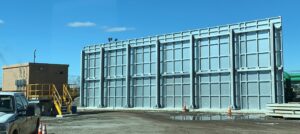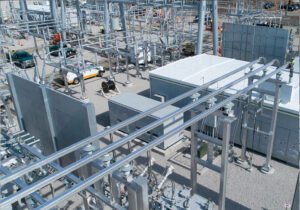Battery Energy Storage Systems (BESS) are revolutionizing the renewable energy landscape, enabling the storage of excess solar and wind power for use when the sun isn’t shining or the wind isn’t blowing. However, as with any energy storage technology, safety is paramount. One often overlooked but crucial component of BESS safety is the implementation of effective fire barriers.
Understanding the Fire Risks in BESS
The batteries within BESS, particularly lithium-ion batteries, store a significant amount of energy. While this energy density is advantageous for storage capacity, it also poses a fire risk. In the event of a malfunction or damage, these batteries can overheat and potentially ignite, leading to a phenomenon known as thermal runaway. Thermal runaway is a chain reaction that can rapidly escalate, releasing even more heat and potentially causing a catastrophic fire.
The Role of Fire Barriers in Mitigating Risks
Fire barriers act as a vital line of defense against the spread of fires within BESS installations. These barriers are designed to compartmentalize the battery storage area, preventing a fire in one module from rapidly spreading to adjacent modules or other critical infrastructure. By containing the fire to a limited area, fire barriers provide valuable time for fire suppression systems to activate and emergency response teams to arrive on the scene.
Types of Fire Barriers for BESS
Various types of fire barriers can be employed in BESS installations, each offering different levels of protection and suitability for specific applications:
- Passive Fire Barriers: These are non-reactive materials that resist the spread of heat and flames. Examples include fire-resistant walls, ceilings, and floors. Passive barriers are a fundamental component of any fire protection strategy.
- Active Fire Barriers: These are systems that actively detect and suppress fires. They often involve the use of fire suppression agents like water, foam, or inert gases. Active barriers provide a rapid response to fire incidents and can significantly reduce the extent of damage.
- Fire-Rated Enclosures: These are specialized enclosures designed to contain fires within the battery module itself. They typically include fire-resistant materials and ventilation systems to manage heat buildup. Fire-rated enclosures can provide an additional layer of protection, especially for high-risk battery chemistries.
Regulatory Requirements and Industry Standards
The importance of fire barriers in BESS is reflected in various regulatory requirements and industry standards. These regulations often mandate the use of fire barriers with specific fire ratings and performance characteristics to ensure adequate protection. Adhering to these standards is not only essential for safety but also for obtaining permits and insurance coverage for BESS installations.
Beyond Fire Barriers: A Holistic Approach to BESS Safety
While fire barriers are a critical component, they should be viewed as part of a comprehensive fire safety strategy for BESS installations. This strategy should also include:
- Regular Inspections and Maintenance: Ensure that fire barriers and other fire safety systems are in good working order.
- Employee Training: Educate staff on fire safety procedures and the proper use of fire suppression equipment.
- Early Detection Systems: Implement smoke detectors, heat sensors, and other early warning systems to detect fires in their initial stages.
- Emergency Response Plans: Develop and practice clear procedures for responding to fire incidents.
Investing in Safety for a Sustainable Future
As the adoption of BESS continues to grow, prioritizing fire safety is not only a matter of protecting assets but also a commitment to the responsible and sustainable development of renewable energy. By investing in effective fire barriers and comprehensive safety measures, we can ensure that BESS installations contribute to a cleaner, safer, and more reliable energy future for all.
Selecting the Right Fire Barriers: A Critical Decision
The choice of fire barriers for a BESS installation is a crucial decision that requires careful consideration of various factors:
- Fire Rating: Fire barriers are rated based on their ability to withstand fire for a specific duration. The required fire rating will depend on the size of the BESS, the type of batteries used, and local regulations.
- Material Compatibility: The materials used in fire barriers must be compatible with the battery chemistry and other components of the BESS to avoid unintended reactions or degradation.
- Environmental Conditions: Consider the environmental conditions in which the BESS will operate, such as temperature extremes, humidity, and exposure to sunlight or corrosive elements.
- Ease of Installation and Maintenance: Choose fire barriers that are easy to install and maintain to minimize disruptions and ensure ongoing protection.
Integrating Fire Barriers into BESS Design
Fire barriers should be seamlessly integrated into the overall design of the BESS installation. This includes:
- Placement: Strategically place fire barriers to create compartments that limit the potential spread of fire.
- Ventilation: Design ventilation systems that work in conjunction with fire barriers to manage heat and smoke in the event of a fire.
- Accessibility: Ensure that fire barriers do not impede access for maintenance or emergency response personnel.
Case Studies: Real-World Examples of Fire Barrier Effectiveness
Several real-world incidents have highlighted the effectiveness of fire barriers in BESS installations. For example, in 2020, a fire broke out at a BESS facility in Arizona. Thanks to the presence of fire barriers, the fire was contained to a single battery rack, preventing it from spreading to the rest of the installation and causing a much larger incident. This incident underscores the critical role that fire barriers play in protecting valuable assets and ensuring the safety of personnel.
The Future of Fire Barriers in BESS: Innovation and Advancement
As BESS technology continues to evolve, so too are the fire barriers designed to protect it. Ongoing research and development are focused on creating more effective, efficient, and sustainable fire barrier solutions. Some of the emerging trends include:
- Smart Fire Barriers: These barriers incorporate sensors and other technologies to detect fires early and activate suppression systems automatically.
- Lightweight and Flexible Fire Barriers: These are designed to be easier to install and adapt to different BESS configurations.
- Sustainable Fire Barriers: These are made from environmentally friendly materials and designed to minimize their impact on the environment throughout their lifecycle.
A Shared Responsibility for BESS Safety
The safety of BESS installations is a shared responsibility among manufacturers, installers, operators, and regulators. By working together to develop and implement comprehensive fire safety strategies, we can ensure that BESS technology continues to play a vital role in the transition to a cleaner and more sustainable energy future.




